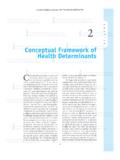Transcription of Economic Growth in Egypt: Constraints and …
1 Economic Growth in Egypt: Constraints and determinants Anton Dobronogov and Farrukh Iqbal October 2005. Abstract Egypt accelerated its ongoing transition from a public sector dominated economy to a private sector led and market oriented economy after the collapse of oil prices in the mid- 1980s. Some aspects of the economy, such as trade policy, have been substantially transformed since then whereas other aspects, such as public control of the financial sector, have experienced less change in substance. We examine some determinants of Growth in Egypt since the mid-1980s using insights from both standard econometric techniques and a diagnostic approach proposed by Hausmann, Rodrik and Velasco (2004). We find that trends in government consumption, credit to the private sector and the average Growth rate of OECD countries have been significant determinants of Growth in Egypt in the past.
2 We also present evidence that suggests that inefficiency of financial intermediation is a significant current constraint on Growth . Economic Growth in Egypt: Constraints and determinants Anton Dobronogov and Farrukh Iqbal 1. 1. Introduction After the collapse of oil prices in the mid-1980s, Egypt became more vigorously engaged in a process of structural reform whose aim was to increase the role of the private sector, the market and international trade in the economy. Since then, Egypt's Growth performance has varied from a declining phase in the latter half of the 1980s, to acceleration through much of the 1990s, followed by another declining phase during 1999-2003. This paper attempts to understand the determinants of this Growth performance through a combination of graphical, econometric and diagnostic techniques.
3 We begin, in Part 2, with a simple graphical depiction of Growth trends in Egypt relative to the OECD. This reveals clear co-movement of the two Growth trends since the mid-1980s, suggesting the progressive deepening of Egypt's integration into the global economy (albeit from low levels). We also examine trends in other variables, such as the share of domestic credit going to the private sector and the Growth of the labor force. Once again, suggestive links are found between trends in these variables and Growth trends. We examine these links more rigorously in Part 3 of the paper through a time series econometric regression. This confirms the significance, on a ceteris paribus basis, of some of the graphical correlations noted earlier.
4 In Part 4, we proceed to examine other possibilities through a diagnostic technique recently proposed by Hausmann, Rodrik and Velasco (2004). In particular, we consider whether Growth in Egypt is likely to have been constrained by low social returns to investment, insufficient private appropriation of investment returns, or a relatively high (shadow) price of financing. We find that the last noted is most likely to have been an important constraint on Growth , especially since 1999. In particular, we find that recent Growth in Egypt has been constrained by inefficiency of financial intermediation rather than lack of financial resources. We examine some of the evidence for this view in Part 5 and offer some concluding remarks in Part 6.
5 2. Growth performance in 1961-2003: phases and trends A major criterion of a developing country's Growth performance suggested in the Economic literature 2 is whether or not the country's Economic Growth rate exceeds that of the world's most developed economies. If the answer to this question is positive, a developing economy is gradually reducing the income differentials with industrialized countries, a phenomenon known as convergence ; otherwise, the income differentials are rising and the economy is falling further behind the leaders. Figure 1 provides a snapshot of Egypt's relative performance between 1961 and 2003 through five-year moving averages of GDP per capita Growth rates for Egypt and high-income OECD.
6 Countries. 1. We are grateful to Barry Eichengreen, Ricardo Hausmann, Dani Rodrik, Roberto Zagha, and anonymous peer-reviewer for their useful comments on the earlier draft of this paper. The standard disclaimer applies. 2. For example, see Barro (1999) and Solow (2000). 1. Figure 1. Economic Growth in Egypt and OECD, 1961-2003. GDP per capita grow th 5 year m oving average 8. 7. 6. % GDP 5. 4. 3. 2. 1. 0. 1960 1965 1970 1975 1980 1985 1990 1995 2000. Egypt OECD. Source: World Development Indicators and authors' calculations Using the convergence criterion, we can distinguish five distinct phases of Egypt's Economic development over the last four decades. We briefly discuss all five phases below while emphasizing that our main interest is in developments since the mid- 1980s.
7 Phase 1: 1961 1973. Low Growth and divergence from OECD. During this period, the state dominated the economy, the share of the private sector in GDP was low, and the government pursued import substitution policies. Over this phase, Egypt invested heavily in public infrastructure and social services (such as health and education) but could not sustain high Economic Growth . Business efficiency and labor productivity stagnated, as the country's development plans aimed at physical output targets, and its industrial exports were oriented mostly towards communist countries with low quality requirements (Weiss and Wurzel, 1998). Phase 2: 1974 1985. High Growth and convergence with OECD. Two factors played a prominent role in Egypt's Growth performance over this period.
8 First, the government launched the Open Door Policy (Infitah), which allowed a greater role for the private sector and partial liberalization of the trade sector and of the exchange rate regime. Second, national income was boosted by a dramatic increase in windfall revenues from the Suez Canal and from petroleum exports. According to Handoussa (2002), their joint value-added share increased from to , and their share in government revenues grew from 5% to close to 35% between 1975 and 1985. In addition, there was a rapid Growth in tourism revenues and workers' remittances from abroad. However, while contributing to rapid Growth of GDP, large windfall revenues caused some deterioration of fiscal institutions (the government's current expenditures dominated by the wage bill, subsidies, and interest payments, rose even faster than its revenues), Dutch disease effect, and increase in inflation to about 15% (Handoussa, 2002).
9 Phase 3: 1986 1991. Low Growth and divergence from OECD. The collapse in windfall revenues following the 1985-86 oil price crash revealed the unsustainability of prevailing fiscal policy as fiscal deficits averaged about 15% of GDP throughout this 2. phase. The deficits were automatically accommodated through expansionary monetary policy, which resulted in inflation rates above 20%. Stagnation of exports and large current account deficits (up to 8% of GDP in 1989) endangered Egypt's ability to serve its external debt (Subramanian, 1997). Confidence in the economy ebbed, and government's attempts to maintain a fixed exchange rate resulted in two peaks in the black market premium, when it exceeded 70% (Figure 2). Figure 2.
10 Black market premium in Egypt 120. 100. Black market premium, %. 80. 60. 40. 20. 0. 1960 1965 1970 1975 1980 1985 1990 1995 2000. -20. Year Source: World Currency Yearbooks and Economist Intelligence Unit From this stage on, we observe three consistent trends: (a) a strong correlation between Growth rates in Egypt and OECD (Figure 3); (b) a downward trend in the Growth differential (Figure 1); and (c) a reduction in overall Growth volatility in Egypt bringing it closer to volatility levels observed in the OECD (Figure 4). Figure 3. Correlation between GDP Growth rates of OECD and Egypt Egypt and OECD Growth rates: moving 5-year correlation 1. Correlation coefficient 0. 1965 1970 1975 1980 1985 1990 1995 2000. -1.














